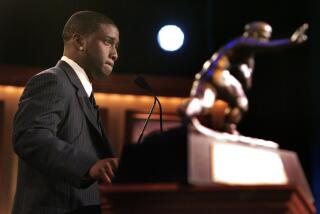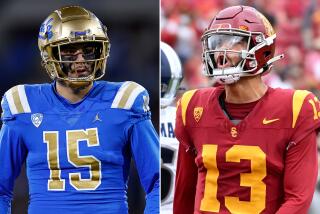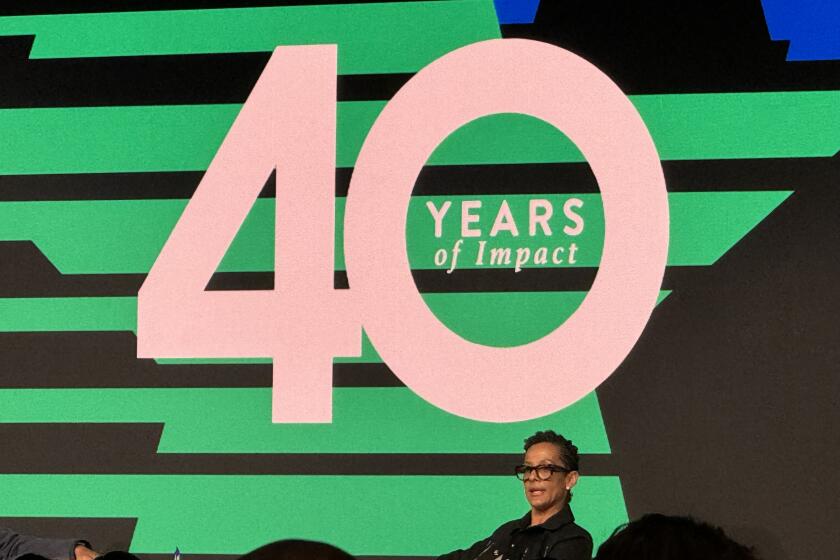24 Top Passers
With a quarterback named Jake Delhomme, the unbeaten Carolina Panthers (5-0) will entertain a preseason Super Bowl favorite next Sunday, the Tennessee Titans (4-2), whose passer, Steve McNair, proved again in NFL Week 6 that he’s an all-pro candidate.
With a pair of backup quarterbacks, Gus Frerotte and Steve Beuerlein, the Minnesota Vikings and Denver Broncos have also advanced to 5-0 and 5-1, respectively, to set up the Game of Week 7, in which big guns Daunte Culpepper and Jake Plummer will be firing Sunday at Minneapolis.
Under Trent Green, who is one of several St. Louis castoff quarterbacks, the unbeaten Kansas City Chiefs seem best of all.
The Chiefs are 6-0 going into Monday’s night game at Oakland (2-4), whose quarterback is a Super Bowl veteran, Rich Gannon.
What is going on in professional football?
The best answer is that there are good quarterbacks all over the league now although, not long ago, their scarcity was the NFL’s most pressing problem. The change is dramatic. Most pro clubs this year — three of every four — have quarterbacks with a Super Bowl potential.
NFL Is a Balance of the Powerful
MANY FOOTBALL FANS, thinking back a few years, can remember when the best-informed NFL scouts, discussing good quarterbacks, said there were “about six” — and sometimes that was stretching it.
Then suddenly in college football, most coaches developed an interest in passing — after losing a few games to the handful of early-bird good passers — and began polishing their quarterbacks as industriously as they once polished blockers and tacklers.
And the revolution was on. All over the college landscape, good quarterbacks appeared. And as they matured, the best of them moved into the NFL, where they joined the best of football’s blockers and tacklers to create what the pros have today: an extremely competitive league that is better than ever.
Formerly, it was politically correct to say that NFL parity suggests a balance of mediocrity. Critics used to complain that steady expansion — 32 pro clubs now — had so diluted the available personnel that the teams were mostly all weak.
To the contrary, it’s clear today that they are mostly all strong. When you can see that the NFL is rife with good quarterbacks — and when you know the quarterbacks are products of college systems in which highly polished players are developed at all other positions — you realize that the pro league today is crowded with the best of the best. The NFL, whatever it used to be, has become a balance of the powerful.
Only Eight Teams Still Wanting
CHICAGO’S HUB ARKUSH, the Cub fan who runs Pro Football Weekly as editor and publisher, set out recently to reckon the NFL’s best quarterbacks but lost count after 15 or 16 names.
Arkush’s goal was to fix Donovan McNabb’s place in the pro hierarchy, where, he said, reflecting a majority view, McNabb is in the top 5. Had the Arkush objective been different, he could easily have run the total of good quarterbacks to two dozen. Of the 32 pro clubs, 24 of them, I’d say, are in the hands of quarterbacks whose capability ranges from excellent to acceptable.
Indeed, it’s easier to name the eight teams still wanting than the 24 already there.
In the NFC, despite Kordell Stewart’s promise, Chicago seems wanting, as does Arizona with Jeff Blake. Mainly, Blake and Stewart have been unlucky to spend their pro careers in sub-par offensive systems. Nor can it be said that Delhomme is the answer at Carolina, which wins with running power and defense.
Three AFC teams also lack first-rate quarterbacks: Miami (Jay Fiedler), Baltimore (Kyle Boller) and Cincinnati (Jon Kitna) — even though, in more successful offenses, all three could at least match Delhomme’s achievements so far.
Two other AFC teams are led by question-mark quarterbacks. At Pittsburgh, Tommy Maddox seemed the answer last year — but this year, for whatever reason, has been different. At Cleveland, Tim Couch wasn’t the answer last year — but this year might be different. He has gone 2-1 starting in place of Kelly Holcomb, who has looked like a Super Bowl quarterback in brief appearances but is just now returning to health after fracturing his fibula in the Browns’ victory over San Francisco last month.
AFC: Eleven of Sixteen QBs Effective
AS THE QUARTERBACKS keep making big plays this year, large numbers of pro games are being decided in the fourth quarter. Many games go down to the wire, to be won and lost on the final few plays, often on the last play of the game. For this, the NFL’s balance of quarterback strength provides one clear explanation.
In the younger conference:
The AFC West has three excellent quarterbacks, Jake Plummer, Trent Green and Rich Gannon — plus another one, Drew Brees, acceptable now, who would be much better than that if surrounded by the kind of help the leaders have.
Of the 11 AFC quarterbacks who play effectively (in a 16-team conference), two are in the AFC South, Peyton Manning and Steve McNair, who both approach greatness. At expansion Houston, David Carr seems acceptable. At rebuilding Jacksonville, the acceptable veteran is Mark Brunell, backed by a seemingly promising rookie Byron Leftwich.
The AFC North is still looking for a few good quarterbacks.
But the AFC East has three with Super Bowl quality, present, past or future, Tom Brady, Drew Bledsoe and Chad Pennington.
NFC: Thirteen of Sixteen Clubs OK at QB
IN THE SENIOR conference, 13 of the 16 teams have proved, to the satisfaction of most NFL scouts, that they’ve hired or developed quality quarterbacks:
In the NFC West, there are four on three clubs, Marc Bulger, Kurt Warner, Jeff Garcia and Matt Hasselbeck.
The NFC South has produced three past or potential Super Bowl quarterbacks, Brad Johnson, Michael Vick and Aaron Brooks.
In the NFC North, there are three more, Brett Favre, Daunte Culpepper and, at Detroit, Joey Harrington, when and if he gets more help.
The NFC East seems as well off at quarterback as any division in football with Donovan McNabb, Kerry Collins, and the two new ones, Quincy Carter and Patrick Ramsey — the two who have lucked onto teams with coaches (Bill Parcells and Steve Spurrier) that Jeff Blake, Kordell Stewart and many other NFL quarterbacks would die for.
More Class Defensive Acts Than Ever
NFL DEFENSIVE TEAMS are also stronger and faster than ever this season.
The explanation for the league’s defensive excellence also starts with college football: If, demonstrably, the colleges are turning out more good quarterbacks than ever, it’s likely that they’re doing the same for defensive people.
For, after attending a spread of U.S. colleges and universities, large and small, the NFL’s defensive as well as offensive players are 1) products of the same extraordinary modern college football system and 2) the best of the best.
Today’s NFL defensive clubs have become so powerful that pro football’s critics and other observers would be seeking rule changes penalizing defenses again — as they did in the low-scoring days of the 1970s and at other times — if the quarterbacks weren’t so dominant in the close, big games.
College teams in the 1970s weren’t producing many great pro quarterbacks. They didn’t have to. The most successful college coaches were winning with wishbone-formation running plays and other option running plays.
The passing revolution that began at San Francisco in the early 1980s with Coach Bill Walsh’s 49er teams — which won an unprecedented five Super Bowls with short ball-control passes by Joe Montana and Steve Young — was embraced in time at most colleges.
When their coaches finally agreed with Walsh that ball-control pass plays provide a more certain way to win than ball-control running plays, the seeds were dropped for what you see today: wide-open college passing.
The skill to throw ball-control passes accurately and routinely — along with a bomb or two and a selection of mid-range beauties — has changed football completely because there are so many quarterbacks who can do that now if properly coached and if placed in a league that values such football. Hence the NFL today.
Ram Excitement Is No More: The Thrill Is Gone
NFL SCHEDULES ARE lined up long in advance. So when the Atlanta Falcons were billed into St. Louis for a Ram game on an October Monday night, it looked like a football classic — the league’s most exciting player, Atlanta quarterback Michael Vick, vs. the league’s most exciting team.
It didn’t turn out that way. During the exhibition season, Vick broke a leg. And the Rams, in Mike Martz’s third year as their coach, have lost their excitement.
They overwhelmed Atlanta with great ease, 36-0, only because the Falcons didn’t put up a fight and because the Rams still have a few great players — three in particular, quarterback Marc Bulger and wide receivers Isaac Bruce and Torry Holt — but they looked like what they are, a plodding 3-2 team. Unhappily for Ram fans, the thrill is gone.
When Atlanta didn’t bother to sign a competent backup for Vick, this game was irretrievably lost to the Falcons. And their players played as if they understood, on both sides of the ball. This night, the Falcons were just going through the motions.
The Rams, though, played as if the Falcons worried them. They attacked Atlanta tentatively — like any other NFL team — with power plays on first down and with pass plays only when they couldn’t be avoided.
Yet Bruce is still so magnificent that he could make the same old big smooth catches, even in traffic, even on obvious passing downs. And when necessary, so could Holt. And Bulger, untouched through the night by any Falcon, worked as effortlessly as if this were a training-camp scrimmage. So the Rams kept scoring — in conventional NFL ways, like any other NFL team when it has an opponent outmanned.
It didn’t used to be this way on the Ram club. There was a time when Martz had the most spectacular offense of all time. In Martz’s heyday as a Super Bowl play-caller — one win, one close loss — the Rams used to come out of the huddle throwing the ball. They’ve been known to throw it on 17 consecutive plays.
Or sometimes, in the midst of all the straight-flying passes — which enabled the Rams to score an unprecedented 500 points in each of three consecutive seasons — they’ve surprised their opponents with counterpunch runs on passing downs, gaining big yardage before resuming their pass-play offense.
Play-selection used to be Martz’s long suit, alongside play design, and the design is still there, but not the bold play-calling. He appears to have been badly hurt by the critics who repeatedly told him to quit throwing all those wonderful passes and call more runs. Every analyst on TV except Phil Simms still says football is a game of running the ball and defending runs — and though they’ll never convince Martz, they can influence him, obviously. For the worse.
Against Atlanta if the Rams had played the familiar old Martz way, they’d have had their 36 points by halftime and could have practiced their reserves in the second half. With the Green Bay Packers coming in Sunday, that would have benefited Martz’s team all around. But it didn’t happen. For the Rams, and for their fans, the thrill is gone.
Bob Oates’ book, Sixty Years of Winners, is available at latimes.com/bookstore or by calling (800) 246-4042 ($16.95).
More to Read
Get our high school sports newsletter
Prep Rally is devoted to the SoCal high school sports experience, bringing you scores, stories and a behind-the-scenes look at what makes prep sports so popular.
You may occasionally receive promotional content from the Los Angeles Times.






